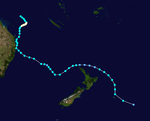1973–74 South Pacific cyclone season
Appearance
| 1973–74 South Pacific cyclone season | |
|---|---|
 Season summary map | |
| Seasonal boundaries | |
| First system formed | November 7, 1973 |
| Last system dissipated | April 28, 1974 |
| Strongest storm | |
| Name | Pam |
| • Maximum winds | 205 km/h (125 mph) (10-minute sustained) |
| • Lowest pressure | 928 hPa (mbar) |
| Seasonal statistics | |
| Total disturbances | 10 |
| Tropical cyclones | 10 |
| Severe tropical cyclones | 2 |
| Total fatalities | Unknown |
| Total damage | Unknown |
| Related articles | |
The 1973–74 South Pacific cyclone season was an inactive season. In tropical cyclones, it was an average season, but in strength, it was very inactive, with only two severe tropical cyclones.
Systems
Tropical Cyclone SP7301
| Category 1 tropical cyclone (Australian scale) | |
| Tropical storm (SSHWS) | |
| Duration | November 7 – November 11 |
|---|---|
| Peak intensity | 65 km/h (40 mph) (10-min); 990 hPa (mbar) |
Severe Tropical Cyclone Natalie-Lottie
| Category 3 severe tropical cyclone (Australian scale) | |
| Category 1 tropical cyclone (SSHWS) | |
| Duration | December 1 – December 11 |
|---|---|
| Peak intensity | 120 km/h (75 mph) (10-min); 965 hPa (mbar) |
This storm formed as Natalie, then moved into the Australian region the same day. Later it moved back into the SPac and was renamed Lottie.[1] High seas caused the ship Uluilakeba to capsize killing more than 85 people. [1] [2] This makes Lottie one of the deadliest tropical cyclone in region in recent decades.[2]
Tropical Cyclone Monica
| Category 1 tropical cyclone (Australian scale) | |
| Tropical storm (SSHWS) | |
| Duration | January 15 – January 20 |
|---|---|
| Peak intensity | 65 km/h (40 mph) (10-min); 990 hPa (mbar) |
Tropical Cyclone Nessie
| Category 1 tropical cyclone (Australian scale) | |
| Tropical storm (SSHWS) | |
| Duration | January 17 – January 22 |
|---|---|
| Peak intensity | 65 km/h (40 mph) (10-min); 990 hPa (mbar) |
Tropical Cyclone Vera
| Category 2 tropical cyclone (Australian scale) | |
| Tropical storm (SSHWS) | |
| Duration | January 21 – January 22 |
|---|---|
| Peak intensity | 95 km/h (60 mph) (10-min); 985 hPa (mbar) |
Severe Tropical Cyclone Pam
| Category 5 severe tropical cyclone (Australian scale) | |
| Category 2 tropical cyclone (SSHWS) | |
| Duration | January 30 – February 8 |
|---|---|
| Peak intensity | 205 km/h (125 mph) (10-min); 928 hPa (mbar) |
Tropical Cyclone Zoe
| Category 2 tropical cyclone (Australian scale) | |
| Tropical storm (SSHWS) | |
| Duration | March 14 – March 20 |
|---|---|
| Peak intensity | 100 km/h (65 mph) (10-min); 980 hPa (mbar) |
Tropical Cyclone Alice
| Category 2 tropical cyclone (Australian scale) | |
| Tropical storm (SSHWS) | |
| Duration | March 23 – March 30 |
|---|---|
| Peak intensity | 100 km/h (65 mph) (10-min); 980 hPa (mbar) |
Tropical Cyclone Tina
| Category 2 tropical cyclone (Australian scale) | |
| Duration | April 23 – April 28 |
|---|---|
| Peak intensity | 100 km/h (65 mph) (10-min); 980 hPa (mbar) |
See also
- Atlantic hurricane seasons: 1973, 1974
- Eastern Pacific hurricane seasons: 1973, 1974
- Western Pacific typhoon seasons: 1973, 1974
- North Indian Ocean cyclone seasons: 1973, 1974
References
- ^ "Tropical Cyclone Natalie-Lottie track map". Australia Severe Weather.com. Retrieved 2009-07-05.
- ^ "Cyclone (Daman) spared populated parts of Fiji". Associated Press. December 10, 2007. Archived from the original on December 7, 2007. Retrieved 2009-07-05.









